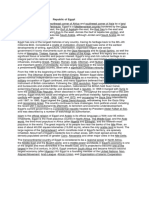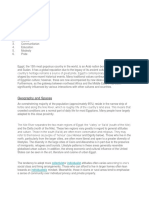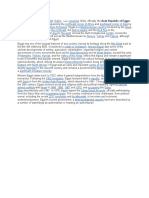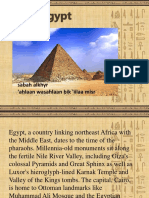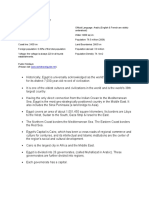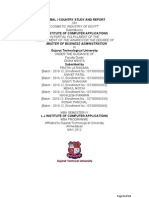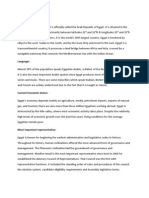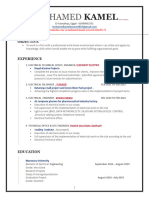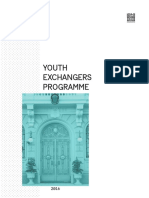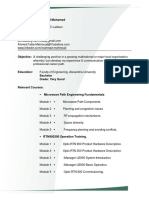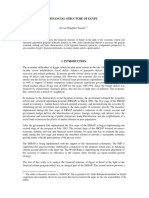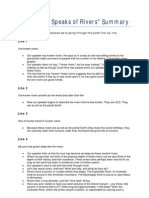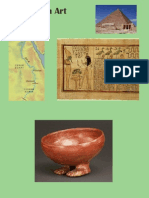Egypt – Modern Muslim World Assignment
Name: Umar Khan
Group: 1
Course: Modern Muslim World
Submitted To: Arfat Rauf
Date: 4-6-2025
1
�SEGMENT A: GEOGRAPHY & DEMOGRAPHY
Egypt is a country situated in the northeastern corner of Africa, and it also includes the
Sinai Peninsula in Asia, making it a transcontinental nation. Egypt shares borders with
Libya to the west, Sudan to the south, Israel and the Gaza Strip to the northeast, the
Mediterranean Sea to the north, and the Red Sea to the east. This strategic geographical
location has made Egypt historically important in trade and politics, especially because it
connects Africa, Asia, and Europe. The total land area of Egypt is about 1,002,000 square
kilometers, most of which is covered by desert terrain.
The Western Desert and the Eastern Desert are the two major desert regions in Egypt.
The Western Desert, part of the Sahara, covers nearly two-thirds of the country. It is an
arid region with sand dunes, rock formations, and some scattered oases such as Siwa,
Bahariya, Farafra, and Dakhla. These oases are home to small communities and serve as
important sources of agriculture and tourism. The Eastern Desert lies between the Nile
River and the Red Sea. It is rocky and mountainous and contains several mineral
resources, including gold and other metals.
The most important geographical feature of Egypt is the Nile River. The Nile flows from
the south to the north, covering about 1,500 kilometers within Egypt before emptying
into the Mediterranean Sea. It is the longest river in the world and has been central to
Egyptian life for thousands of years. The river provides water for agriculture, drinking,
and transportation. It also creates a narrow strip of fertile land in an otherwise arid
environment. Nearly all of Egypt’s population lives in the Nile Valley and Nile Delta
regions because of the fertile soil and access to water.
The Nile Delta is a fan-shaped area in northern Egypt where the river splits into several
branches before flowing into the sea. The delta is extremely fertile and supports intense
agriculture, particularly the cultivation of rice, cotton, wheat, and vegetables. This
region is densely populated and is home to several important cities.
Egypt’s climate is mostly desert, with hot summers and mild winters. Rainfall is minimal
and occurs mainly along the northern coast. Temperatures in summer can exceed 40°C
in the interior deserts, while coastal cities like Alexandria and Port Said experience
milder weather. Winters are more pleasant, with average daytime temperatures ranging
from 14°C to 22°C.
Vegetation in Egypt is limited due to the harsh climate. Natural flora is mainly composed
of desert shrubs and plants that can survive with minimal water. Along the Nile and in
the oases, palm trees, acacia trees, and various types of grasses are found. Forests do
not exist in Egypt in the traditional sense.
2
�Egypt also has several mountain ranges. The Sinai Peninsula is home to some of the
most prominent peaks, including Mount Catherine, which is the highest mountain in
Egypt at 2,629 meters. This region is of religious and historical significance, especially for
followers of Christianity, Islam, and Judaism.
Major cities in Egypt include Cairo, Alexandria, Giza, Luxor, Aswan, Suez, and Port Said.
Cairo is the capital and the largest city in Egypt and Africa. It is located near the Nile
Delta and is the political, cultural, and economic hub of the country. Alexandria, a
coastal city founded by Alexander the Great, is the second-largest city and an important
seaport. Giza, located near Cairo, is world-famous for the Pyramids and the Sphinx.
Luxor and Aswan are important historical cities in Upper Egypt, rich with temples and
monuments from ancient Egypt.
Egypt’s population exceeds 110 million people, making it the most populous country in
the Arab world and the third most populous in Africa. The population density is
extremely high in the Nile Valley and Delta, while the deserts remain sparsely inhabited.
The country has a youthful population, with over 60% of Egyptians under the age of 30.
This demographic structure creates opportunities for growth but also presents
challenges in education, employment, and housing.
Gender distribution in Egypt is relatively balanced, with a slightly higher number of
males than females. Life expectancy in Egypt has improved significantly in recent
decades, currently standing at around 73 years. This improvement is due to better
access to healthcare, improved nutrition, and public health initiatives. However,
healthcare services are still unevenly distributed, with rural areas having less access
than urban centers.
Egypt is predominantly Sunni Muslim, with Islam playing a central role in daily life and
public policy. About 10% of the population is Christian, mainly belonging to the Coptic
Orthodox Church. Arabic is the official language, and Egyptian Arabic is the most widely
spoken dialect.
Two of the most significant infrastructure projects in Egypt are the Suez Canal and the
Aswan High Dam. The Suez Canal is a man-made waterway connecting the
Mediterranean Sea with the Red Sea. It was completed in 1869 and allows ships to
travel between Europe and Asia without navigating around the African continent. The
canal is one of the most important trade routes in the world and is a major source of
income for Egypt through toll revenues.
The Aswan High Dam, completed in 1970, is located on the Nile River in southern Egypt.
It was built to control flooding, provide water for irrigation, and generate hydroelectric
power. The dam created Lake Nasser, one of the largest artificial lakes in the world.
3
�While the dam has helped improve agriculture and electricity supply, it has also led to
environmental changes, including reduced silt deposits in the Nile Delta.
In conclusion, Egypt’s geography is shaped by the vast deserts and the life-giving Nile
River. Its strategic location, rich natural resources, and youthful population offer great
potential for development. Understanding the geography and demography of Egypt is
essential to appreciating its historical importance and contemporary challenges.
SEGMENT B: ECONOMY
Egypt's economy is one of the largest in Africa and the Middle East. It is classified as a
developing mixed economy. This means that the economy includes various sectors
such as agriculture, industry, and services. The Egyptian government plays a major role
in controlling some sectors, while other sectors are open to private and foreign
investments.
Over the past decade, Egypt has made progress in reforming its economy. The
government has taken steps to reduce budget deficits, attract foreign investments,
and support small businesses. Despite challenges, Egypt's economy has shown signs of
growth. For example, before the COVID-19 pandemic, the GDP growth rate was around
5.6%, one of the highest in the region. Although growth slowed during the pandemic,
recovery has been underway with support from international financial institutions.
Unemployment has been a consistent issue in Egypt. The unemployment rate stands
around 7.5% to 9%, but it is higher among youth and women. Many young Egyptians,
even those with university degrees, face difficulty in finding appropriate jobs. To
address this issue, the government has introduced programs focused on skill
development, vocational training, and entrepreneurship support.
Inflation has also affected Egypt's economy. After the currency devaluation in 2016,
inflation rates rose sharply, peaking at over 30% in 2017. Although inflation has
decreased since then, it still affects the cost of living for ordinary Egyptians. The
government has reduced subsidies on fuel and food to manage its budget, but this has
4
�led to higher prices for many basic goods. To support the poor, social protection
programs like Takaful and Karama have been implemented.
The economy of Egypt is divided into three main sectors:
1. Agriculture:Egypt’s agriculture is mostly dependent on the Nile River for
irrigation. Main crops include wheat, rice, maize, cotton, sugarcane, and
vegetables. Although agriculture employs about 20% of the population, its share
in GDP is relatively small. Farming in Egypt faces issues such as limited water
resources, outdated techniques, and land degradation.
2. Industry: Egypt has a strong industrial sector that includes petroleum, natural
gas, textiles, cement, steel, and food processing. Oil and gas are the most
important sources of export income. Egypt is a significant energy producer in
North Africa. The discovery of natural gas fields like Zohr has made Egypt energy
independent and even a gas exporter. The government is also working to develop
new industrial zones and attract foreign investment in manufacturing.
5
� 3. Services:The services sector contributes the most to GDP. It includes tourism,
banking, telecommunications, education, and retail. Tourism is one of the top
income sources for Egypt, attracting millions of tourists to historical sites such as
the Pyramids of Giza, the temples of Luxor and Karnak, and the Nile River
cruises. Political stability and infrastructure development are helping revive the
tourism sector after years of decline.
Egypt’s per capita GDP is around $3,800, indicating a middle-income economy.
However, poverty remains a challenge. Approximately 29% of Egyptians live below the
national poverty line. The government is working with the World Bank and other
international partners to reduce poverty through education, health, and
infrastructure investments.
Egypt has a favorable location for trade. The Suez Canal, a major global shipping
route, allows vessels to pass between Europe and Asia without traveling around
Africa. The canal generates billions in annual revenue for Egypt. The government is
also investing in the Suez Canal Economic Zone to attract industries, logistics
companies, and investors.
Exports include petroleum and petroleum products, cotton, textiles, chemicals, fruits,
and vegetables. Imports include machinery, equipment, food, chemicals, and vehicles.
Egypt maintains trade relations with countries in the EU, Middle East, China, and the
USA.
SEGMENT C: HISTORY
Egypt has one of the oldest civilizations in the world, but in this section we focus on its
history over the last 150 years. Egypt was under Ottoman rule until the British
occupied the country in 1882. Although Egypt remained officially part of the Ottoman
Empire, Britain controlled its political and economic systems, mainly to protect its
interests in the Suez Canal.
In 1922, Egypt gained nominal independence and became a kingdom under King Fuad
I. However, British influence continued. The 1936 treaty allowed Britain to keep
6
�troops in Egypt to protect the canal. This created unrest among Egyptians, especially
the younger generation.
In 1952, a group of army officers known as the Free Officers Movement, led by Gamal
Abdel Nasser, overthrew King Farouk. This marked the end of the monarchy and the
beginning of the Republic of Egypt. Nasser became the second president of Egypt and
introduced major reforms. He nationalized the Suez Canal in 1956, which led to the
Suez Crisis. Britain, France, and Israel invaded Egypt, but under international pressure,
they were forced to withdraw. Nasser became a hero in the Arab world.
Nasser's presidency focused on Arab unity, socialism, and anti-imperialism. He
introduced land reforms, built the Aswan High Dam, and improved education.
However, he also suppressed political opponents and restricted freedom of speech.
After his death in 1970, Anwar Sadat became president.
Sadat changed Egypt's direction. He ended close ties with the Soviet Union and
developed relations with the West. In 1973, Egypt and Syria launched a war against
Israel to regain land lost in 1967. The war helped restore Egypt's pride. In 1979, Sadat
signed a peace treaty with Israel, the first Arab leader to do so. This made him a
controversial figure in the Arab world and led to his assassination in 1981.
7
� Hosni Mubarak took over and ruled Egypt for nearly 30 years. His era was marked by
economic growth and political stability but also by corruption, poverty, and lack of
political freedom. In 2011, inspired by the Arab Spring, millions of Egyptians protested
against Mubarak, and he resigned.
In 2012, Mohamed Morsi from the Muslim Brotherhood became Egypt's first
democratically elected president. His rule was short-lived due to political and social
tensions. In 2013, the military removed Morsi from power, and General Abdel Fattah
el-Sisi became president.
The Muslim Brotherhood, founded in 1928 by Hassan al-Banna, has played a major role
in modern Egyptian history. It started as a social and religious movement but later
became politically active. The group has faced bans, arrests, and conflicts with the
government over the years. It remains a controversial and influential force.
SEGMENT D: CULTURE AND SOCIETY
Egyptian culture is one of the oldest and richest cultures in the world. It has been
shaped by various civilizations over thousands of years. Ancient Egyptian civilization left
behind pyramids, temples, and tombs that continue to fascinate people worldwide. The
culture of Egypt reflects its long history, religion, geography, and its role as a
crossroads between Africa, Asia, and Europe.
In ancient times, Egyptians believed in many gods and built massive temples and
pyramids. Their contributions to art, architecture, writing (hieroglyphics), and
medicine were significant. Ancient Egyptian culture influenced Greek and Roman
civilizations, which also ruled Egypt for several centuries.
Christianity came to Egypt in the first century AD, and Alexandria became an
important religious and intellectual center. The Coptic Orthodox Church developed in
Egypt and remains strong today. In the 7th century, Islam spread to Egypt, and over
time, it became the dominant religion. Today, about 90% of Egyptians are Muslims,
mostly Sunni, and about 10% are Christians, mostly Coptic Orthodox.
8
�Egyptian society is traditional but also open to modern influences. Family is the central
unit in society. Most Egyptians live in close-knit families and respect elders. Marriages,
funerals, and religious festivals are important social events.
Clothing is generally modest, especially for women. In cities, people may dress in
Western-style clothing, but in rural areas, traditional clothes like the galabeya are
common. Many women wear the hijab, although wearing it is a personal choice.
Religion plays a big role in daily life. People pray regularly, fast during Ramadan, and
celebrate religious holidays such as Eid al-Fitr and Eid al-Adha. Christians also
celebrate Christmas and Easter. Mosques and churches are found across the country
and are important community centers.
Education is highly valued. The government has made efforts to improve access to
education, especially for girls. Literacy rates have improved, but there are still
challenges, especially in rural areas where schools may be underfunded.
9
�Egypt has a rich tradition of literature, music, and cinema. Writers like Naguib
Mahfouz, the Nobel Prize winner, are world-famous. Egyptian music and films
are popular across the Arab world. Cairo is considered the cultural capital of the
Arab world.
Food is an important part of Egyptian culture. Traditional dishes include koshari
(a mix of rice, pasta, and lentils), ful medames (mashed fava beans), molokhia
(a leafy green soup), and falafel. Meals are often shared with family, and
hospitality is an important cultural value.
In recent years, Egyptian society has been affected by globalization, the
internet, and social media. Young people are using these tools to express
themselves, start businesses, and connect with the world. However,
unemployment and rising living costs remain major issues.
In summary, Egypt’s culture and society are a blend of ancient traditions and
modern influences. Religion, family, and education are central to life. Despite
challenges, Egyptians are proud of their history and hopeful for the future.













